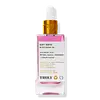What's inside
What's inside
 Key Ingredients
Key Ingredients

 Benefits
Benefits

 Concerns
Concerns

 Ingredients Side-by-side
Ingredients Side-by-side

Caprylic/Capric Triglyceride
MaskingParfum
MaskingSimmondsia Chinensis Seed Oil
EmollientVitis Vinifera Seed Oil
EmollientTocopheryl Acetate
AntioxidantPassiflora Incarnata Seed Oil
Skin ProtectingLavandula Angustifolia Oil
MaskingCocos Nucifera Oil
MaskingAdansonia Digitata Seed Oil
EmollientCarthamus Tinctorius Seed Oil
MaskingFragaria Vesca Fruit Extract
AstringentSodium Hyaluronate
HumectantVanilla Planifolia Fruit Oil
EmollientHydrolyzed Rice Protein
Skin ConditioningLinoleic Acid
CleansingLinolenic Acid
CleansingTocopherol
AntioxidantCitric Acid
BufferingSodium Benzoate
MaskingWater
Skin ConditioningBenzyl Benzoate
AntimicrobialPhenoxyethanol
PreservativeCI 26100
Cosmetic ColorantCaprylic/Capric Triglyceride, Parfum, Simmondsia Chinensis Seed Oil, Vitis Vinifera Seed Oil, Tocopheryl Acetate, Passiflora Incarnata Seed Oil, Lavandula Angustifolia Oil, Cocos Nucifera Oil, Adansonia Digitata Seed Oil, Carthamus Tinctorius Seed Oil, Fragaria Vesca Fruit Extract, Sodium Hyaluronate, Vanilla Planifolia Fruit Oil, Hydrolyzed Rice Protein, Linoleic Acid, Linolenic Acid, Tocopherol, Citric Acid, Sodium Benzoate, Water, Benzyl Benzoate, Phenoxyethanol, CI 26100
Ricinus Communis Seed Oil
MaskingVitis Vinifera Seed Oil
EmollientCaprylic/Capric Triglyceride
MaskingCarthamus Tinctorius Seed Oil
MaskingPrunus Amygdalus Dulcis Oil
Skin ConditioningSimmondsia Chinensis Seed Oil
EmollientLavandula Angustifolia Oil
MaskingSalvia Sclarea Oil
MaskingCalophyllum Inophyllum Seed Oil
AntimicrobialBorago Officinalis Seed Oil
EmollientOenothera Biennis Oil
EmollientTocopheryl Acetate
AntioxidantBisabolol
MaskingMelaleuca Alternifolia Leaf Oil
AntioxidantLinalool
PerfumingLimonene
PerfumingGeraniol
PerfumingRicinus Communis Seed Oil, Vitis Vinifera Seed Oil, Caprylic/Capric Triglyceride, Carthamus Tinctorius Seed Oil, Prunus Amygdalus Dulcis Oil, Simmondsia Chinensis Seed Oil, Lavandula Angustifolia Oil, Salvia Sclarea Oil, Calophyllum Inophyllum Seed Oil, Borago Officinalis Seed Oil, Oenothera Biennis Oil, Tocopheryl Acetate, Bisabolol, Melaleuca Alternifolia Leaf Oil, Linalool, Limonene, Geraniol
Ingredients Explained
These ingredients are found in both products.
Ingredients higher up in an ingredient list are typically present in a larger amount.
This ingredient is an emollient, solvent, and texture enhancer. It is considered a skin-softener by helping the skin prevent moisture loss.
It helps thicken a product's formula and makes it easier to spread by dissolving clumping compounds.
Caprylic Triglyceride is made by combining glycerin with coconut oil, forming a clear liquid.
While there is an assumption Caprylic Triglyceride can clog pores due to it being derived from coconut oil, there is no research supporting this.
Learn more about Caprylic/Capric TriglycerideCarthamus tinctorius seed oil comes from safflower, one of humanity's oldest crops.
Safflower seed oil contains a high percentage of linoleic acid and oleic acid. It also contains Vitamin E. These three components are effective moisturizers.
Vitamin E helps nourish your skin's lipid barrier. It is also a potent antioxidant. Antioxidants help fight free-radical molecules, or unstable molecules that may damage your skin cells.
Due to its high fatty acid content, this ingredient may not be malassezia folliculitis safe.
Thoughout history, safflower has been used for dying fabrics and in food as a saffron substitute.
Learn more about Carthamus Tinctorius Seed OilLavandula Angustifolia Oil is more commonly known as lavender essential oil. It is considered a fragrancing ingredient.
Lavender imparts a famous scent. While the smell is lovely, this ingredient and may sensitize skin in topical products. This is because about 85% of the oil is made up of linalool and linalyl acetate.
When exposed to air, these two compounds become strong allergens. This ingredient exhibits cytotoxicity at low concentrations; amounts of 0.25% have been shown to damage skin cells.
A study from Japan found this ingredient caused lavender sensitivity after widespread exposure.
Lavender essential oil has some antimicrobial, antibacterial, and anti-inflammatory properties. However, the cons of this ingredient may outweight the pros.
More research is needed to confirm lavender essential oil's effects when used in aromatherapy.
Lavandula Angustifolia is known as the English Lavender and famous for creating purple fields in Provence, France.
Learn more about Lavandula Angustifolia OilThis oil comes from the seeds of the desert shrub called Jojoba. It is more commonly known as jojoba oil, a non-comedogenic oil.
Jojoba oil does not contain fragrance and has many fatty-acids, making it a great soothing ingredient.
It also contains Vitamin E, a great moisturizing ingredient. Vitamin E is also an antioxidant and protects your skin against oxidative damage.
This ingredient humectant properties, meaning it helps draw moisture from the air. This helps keep your skin hydrated.
While jojoba has antibacterial properties, it is only able to kill some strains of bacteria.
Studies also show it helps in wound healing. In fact, Indigenous cultures have used jojoba as a moisturizer and to help treat burns for centuries.
Fun fact: Jojoba oil similar to natural human skin sebum, so it has a great effect on dry skin. It is also promising with helping to regulate sebum production.
Due to its fatty acid content, Jojoba oil may not be fungal acne safe. We recommend speaking with a professional if you have any concerns.
Learn more about Simmondsia Chinensis Seed OilTocopheryl Acetate is AKA Vitamin E. It is an antioxidant and protects your skin from free radicals. Free radicals damage the skin by breaking down collagen.
One study found using Tocopheryl Acetate with Vitamin C decreased the number of sunburned cells.
Tocopheryl Acetate is commonly found in both skincare and dietary supplements.
Learn more about Tocopheryl AcetateVitis Vinifera Seed Oil comes from the grape vine. Grape seeds are a byproduct of creating grape juice or wine.
The components of grape seeds have many skin benefits. Research has found it to be antimicrobial and anti-inflammatory. It also contains many potent antioxidants such as Vitamin E , Vitamin C, proanthocyanidins, polyphenols, flavonoids, and anthocyanins. Proanthocyanidin has been shown to help even out skin tone.
Antioxidants help fight free-radical molecules. Free-radical molecules are capable of damaging our cells and other genetic material. Antioxidants help stabilize free-radicals by donating extra electrons. Grape seed extract may help reduce the signs of aging.
The antimicrobial properties of grape seed may help treat acne. However, more research is needed to support this claim.
Grape seed has also been found to help absorb UV rays. Grape seed extract should not replace your sunscreen.
The fatty acids of grape seed oil give it emollient properties. Emollients help soothe and soften your skin by creating a film. This film traps moisture within, keeping your skin hydrated.
Learn more about Vitis Vinifera Seed Oil